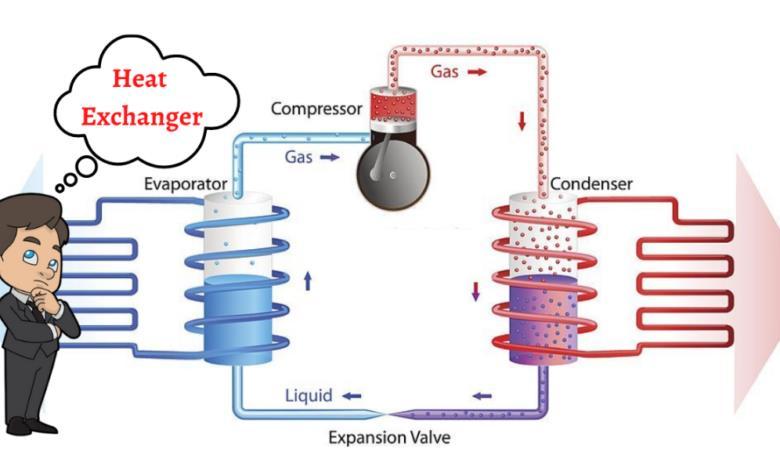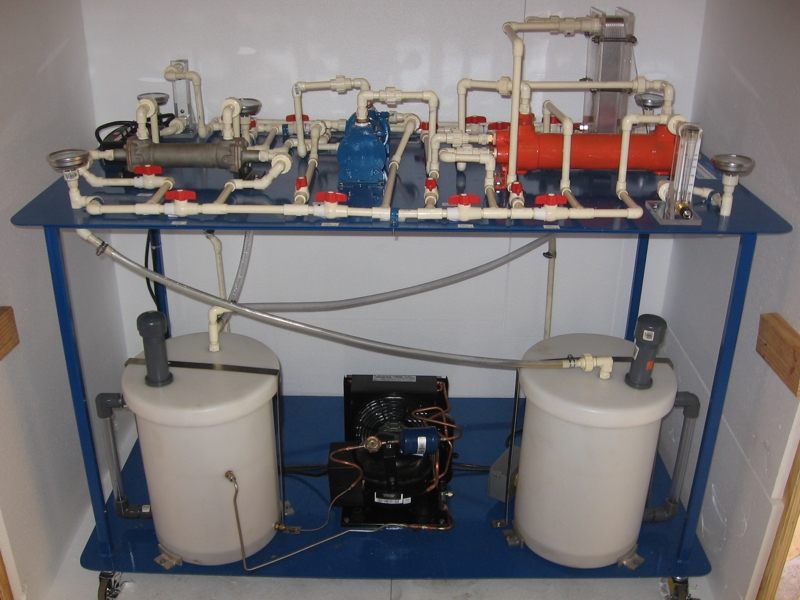Five Techniques DVS Heat Transfer Systems Improve Energy Management in Manufacturing
Wiki Article
Technologies in Heat Transfer Solutions: What You Required to Know for Optimum Efficiency
Technologies in Heat transfer systems are transforming efficiency across numerous industries. Advanced products like graphene and nanofluids promise substantial renovations in thermal conductivity. At the same time, the integration of IoT and artificial intelligence offers opportunities for real-time surveillance and improved power effectiveness. The landscape of thermal monitoring is rapidly advancing. Comprehending these developments is essential for achieving suitable system efficiency and sustainability in the future. What details developments are forming this transformation?Emerging Materials for Enhanced Heat Transfer

Advanced Heat Exchanger Styles
While typical Heat exchangers have actually offered their purpose in different applications, advanced designs are currently arising to meet the raising needs for performance and performance. These innovative styles, such as plate, shell-and-tube, and finned-tube Heat exchangers, include enhanced area and boosted circulation patterns to enhance thermal transfer rates. In enhancement, small styles permit for reduced room needs without jeopardizing performance. Advanced materials, such as composites and corrosion-resistant alloys, furthermore enhance longevity and efficiency under extreme conditions. Simulation innovations and computational liquid characteristics are progressively employed to fine-tune these designs, making certain peak Heat transfer attributes. As industries look for to decrease power usage and optimize outcome, the fostering of advanced Heat exchanger layouts is critical in achieving these objectives.The Function of Nanotechnology in Heat Transfer
Nanotechnology plays an important function in enhancing thermal conductivity within Heat transfer systems. By adjusting products at the nanoscale, scientists have achieved considerable enhancements in energy efficiency. These innovations not only maximize performance yet likewise add to even more sustainable energy solutions.Enhanced Thermal Conductivity
Substantial advancements in thermal conductivity have actually arised with the application of nanotechnology, revolutionizing Heat transfer systems across different sectors. By incorporating nanoparticles into Heat transfer liquids and materials, scientists have actually achieved amazing boosts in thermal conductivity. These nanoparticles, such as carbon nanotubes, graphene, and metal oxides, improve the Heat transfer residential or commercial properties as a result of their high area and special thermal attributes. The resulting compounds display enhanced efficiency in applications varying from electronics cooling down systems to renewable resource innovations. The ability to tailor the size, shape, and make-up of nanoparticles permits for optimized thermal administration services. As a result, nanotechnology remains to play a critical duty in the advancement of a lot more reliable and efficient Heat transfer systems, leading the way for improved industrial applications.
Energy Efficiency Improvements

Integration of IoT in Heat Transfer Solutions
The integration of IoT in Heat transfer systems introduces the execution of clever sensing units that enhance operational performance. These sensing units enable real-time data monitoring, allowing for instant modifications and optimizations. This technological innovation has the possible to substantially enhance performance and energy administration in Heat transfer applications.Smart Sensors Application
As Heat transfer systems advance, the integration of smart sensors with the Internet of Things (IoT) has actually become a transformative method. These sensing units make it possible for real-time monitoring of stress, circulation, and temperature prices, boosting system effectiveness and reliability. By gathering and transmitting information, they promote positive maintenance, minimizing the danger of system failings. In addition, wise sensing units contribute to energy savings by refining functional specifications based on environmental problems. Their capability to examine anomalies and trends permits educated decision-making, ensuring peak performance of Heat transfer systems. As markets increasingly adopt this technology, the execution of smart sensors stands to transform exactly how Heat transfer systems are taken care of, leading the way for greater sustainability and enhanced performance results.Real-Time Data Surveillance
How can real-time data keeping track of enhance the performance of Heat transfer systems? By incorporating Internet of Things (IoT) modern technology, Heat transfer systems can leverage continual information collection from wise sensing units. This real-time monitoring enables instant analysis of temperature level, circulation, and pressure rates, enabling operators to determine ineffectiveness without delay. Subsequently, changes can be made to enhance performance, decrease energy intake, and expand devices life expectancy. In addition, anticipating maintenance can be carried out, decreasing unforeseen downtime and costly repairs. The capability to picture efficiency metrics with dashboards boosts decision-making, cultivating a proactive technique to system administration. Eventually, real-time information checking not only enhances functional efficiency yet also adds to sustainability goals within commercial processes.Energy Performance and Sustainability Trends
Power efficiency and sustainability patterns are improving the landscape of Heat transfer systems, driving innovation and conformity throughout various industries. Organizations are increasingly prioritizing energy-efficient designs to reduce functional prices and lessen ecological effects. The combination of renewable energy sources is ending up being more widespread, allowing Heat transfer systems to run sustainably while fulfilling regulative demands. Additionally, developments in modern technologies and products promote reduced energy intake and enhance general performance. Lifecycle evaluations are likewise gaining traction, permitting business to evaluate the environmental impact of Heat transfer systems from production to disposal. This concentrate on sustainability not only supports company duty however also placements organizations competitively in a market where customers significantly prefer environmentally friendly options. Power performance and sustainability stay critical considerations for future developments in Heat transfer innovation.Innovations in Thermal Administration Solutions
While the demand for reliable Heat transfer remains to increase, developments in thermal monitoring solutions are emerging to resolve both efficiency and sustainability obstacles. Advanced materials, such as phase modification materials and nanofluids, are being established to enhance Heat transfer effectiveness - DVS Heat Transfer Systems. These materials boost thermal conductivity and allow for better temperature level policy in numerous applications. In addition, modern technologies like my review here active thermal control systems are getting grip, enabling real-time adjustments to manage Heat circulation efficiently. These systems contribute to energy savings and reduce the blog here ecological influence of thermal procedures. Furthermore, the combination of IoT in thermal management facilitates monitoring and predictive upkeep, ensuring optimized efficiency and longevity of Heat transfer systems. Overall, these developments represent significant strides toward even more lasting thermal administration methodsFuture Instructions in Heat Transfer Modern Technology
Arising improvements in thermal monitoring remedies indicate a promising future for Heat transfer technology. Researchers are increasingly focusing on developing materials with exceptional thermal conductivity and boosted power performance. Developments such as nanofluids, which contain put on hold nanoparticles, use substantial improvements in Heat transfer efficiency. In addition, the combination of clever materials that adjust to varying temperature conditions is gaining traction, enabling more effective and receptive systems. The increase of additive manufacturing methods is likewise making it possible for the design of complicated Heat exchanger geometries that optimize fluid flow. Furthermore, the implementation of maker knowing algorithms is prepared for to transform the optimization of Heat transfer systems, promoting anticipating upkeep and efficiency improvement. Jointly, these advancements are poised to change the landscape of Heat transfer technologies in various industries.
Frequently Asked Concerns

How Do I Select the Right Heat Transfer System for My Application?
Picking the right Heat transfer system includes assessing application needs, consisting of temperature arrays, fluid buildings, and efficiency demands. Evaluating system kinds, maintenance factors to consider, and cost-effectiveness also plays a crucial role in making an informed decision.What Are the Upkeep Demands for Advanced Heat Exchangers?
Maintenance demands for innovative Heat exchangers typically consist of routine examinations, keeping an eye on for leaks, cleaning of surface areas, and assuring excellent circulation prices. Complying with producer guidelines assurances effective operation and lengthens the tools's life-span.
How Do Environmental Elements Affect Heat Transfer Performance?
Ecological factors significantly influence Heat transfer efficiency. Variations in humidity, temperature, and airflow effect thermal conductivity and convective Heat transfer, inevitably influencing system performance and necessitating factor to consider throughout the layout and procedure of Heat transfer systems.What Security Requirements Relate To Heat Transfer Systems?
Safety standards for Heat transfer systems usually consist of guidelines from organizations such as ASME and ASTM. DVS Heat Transfer Systems. These requirements address products, design, and functional practices to guarantee dependability, performance, and protection against hazards in various applications
Exactly How Can I Fix Usual Heat Transfer System Issues?
Fixing typical Heat transfer system problems includes looking for leaks, making certain appropriate fluid circulation, examining insulation integrity, and verifying temperature differentials. Identifying these aspects can aid maintain system hop over to these guys effectiveness and avoid more complications.Nanotechnology plays an essential duty in enhancing thermal conductivity within Heat transfer systems. Significant improvements in thermal conductivity have actually arised with the application of nanotechnology, changing Heat transfer systems throughout different sectors. Improvements in thermal conductivity via nanotechnology have paved the means for remarkable improvements in power performance within Heat transfer systems. Power performance and sustainability fads are reshaping the landscape of Heat transfer systems, driving development and compliance across numerous markets. The assimilation of IoT in thermal monitoring promotes monitoring and anticipating upkeep, guaranteeing enhanced performance and durability of Heat transfer systems.
Report this wiki page